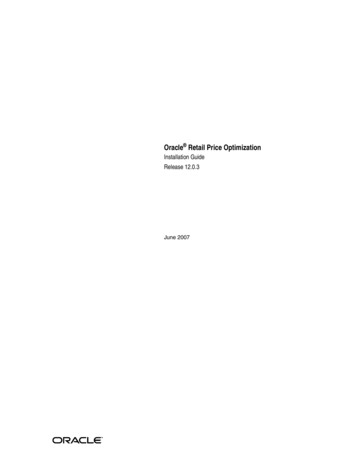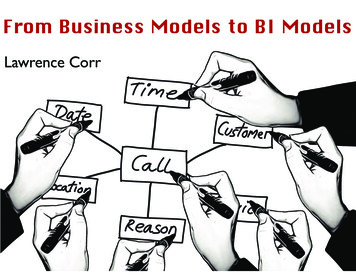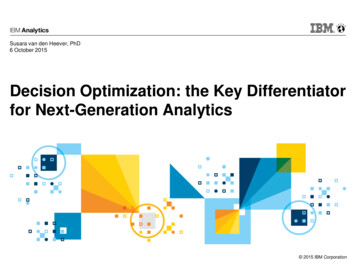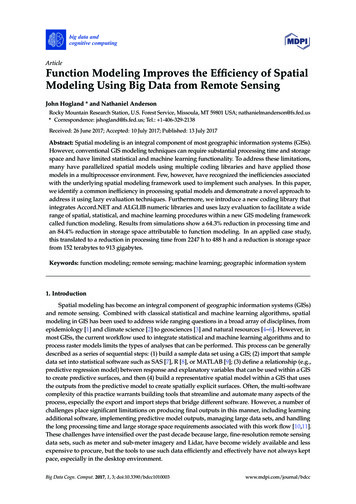
Transcription
ExamensarbeteManpower Planning in Airlines- Modeling and OptimizationÅsa HolmLiTH - MAT - EX - - 2008 / 13 - - SE
Manpower Planning in Airlines- Modeling and OptimizationOptimization, Linköpings UniversitetÅsa HolmLiTH - MAT - EX - - 2008 / 13 - - SEExamensarbete: 30 hpLevel: DSupervisor: Fredrik Altenstedt,Jeppesen, GöteborgExaminer: Torbjörn Larsson,Optimization, Linköpings UniversitetLinköping: August 2008
SpråkLanguagexAvdelning, InstitutionDivision, DepartmentDatumDateMatematiska Institutionen581 83 LINKÖPINGSWEDENAugust 2008RapporttypReport vhandlingExamensarbeteC-uppsatsD-uppsatsÖvrig rapportISBNISRNLiTH - MAT - EX - - 2008 / 13 - - SESerietitel och serienummerTitle of series, numberingISSN0348-2960URL för elektronisk versionhttp://urn.kb.se/resolve?urn urn:nbn:se:liu:diva14757TitelTitleManpower Planning in Airlines - Modeling and OptimizationFörfattareAuthorÅsa HolmSammanfattningAbstractCrew costs are one of the largest expenses for airlines and effective manpowerplanning is therefore important to maximize profit. The focus of research inthe field of manpower planning for airlines has mainly been on the scheduling ofcrew, while other areas, surprisingly, have received very little attention. Thisthesis provides an overview of some of the other problems facing manpowerplanners, such as designing a career ladder, planning transitions and makingcourse schedules.Mathematical models are presented for some of theses problems, and for theproblem of allocating training and vacation in time the mathematical modelhas been tested on data from SAS Scandinavian Airlines. When allocatingtraining and vacation there are many aspects to consider, such as avoidingcrew shortage, access to resources needed for training, and vacation laws.Comparisons between solutions obtained with the model and SAS Scandinavian Airlines manual plan show encouraging results with savings around 10%.NyckelordKeywordManpower planning, Airlines, Optimization, Training allocation
vi
AbstractCrew costs are one of the largest expenses for airlines and effective manpowerplanning is therefore important to maximize profit. The focus of research inthe field of manpower planning for airlines has mainly been on the schedulingof crew, while other areas, surprisingly, have received very little attention.This thesis provides an overview of some of the other problems facing manpower planners, such as designing a career ladder, planning transitions andmaking course schedules.Mathematical models are presented for some of theses problems, and forthe problem of allocating training and vacation in time the mathematicalmodel has been tested on data from SAS Scandinavian Airlines. When allocating training and vacation there are many aspects to consider, such asavoiding crew shortage, access to resources needed for training, and vacation laws. Comparisons between solutions obtained with the model and SASScandinavian Airlines manual plan show encouraging results with savingsaround 10%.Keywords: Manpower planning, Airlines, Optimization, Training allocationHolm, 2008.vii
viii
AcknowledgmentsThis master thesis has been performed at Jeppesen during the spring andsummer of 2008. Jeppesen has kindly provided me with an office at theirGöteborg location and access to the systems and documents needed for thethesis work.I would like to start by thanking my supervisor at Jeppesen, FredrikAltenstedt for his big help and commitment during the entire time. AlsoTomas Gustafson, Eva Bengtsson and Tomas Larsson have been very helpful,patiently answering all of my questions. There are many other at Jeppesenthat in different ways have helped me and I want to thank you all.The personnel at SAS Scandinavian Airlines have helped me tremendously by answering many, many questions and providing me with the dataneeded to test my model, for this I am truly grateful. Especially I want tothank Lena Killander and Tom Sillfors, their knowledge have been invaluablefor this thesis.I would also like to thank my supervisor at LiU, Torbjörn Larsson. Lastly,a special thanks to Susanne Gennow and Paul Vaderlind, without you I wouldnever have found the wonderful world of mathematics.Åsa HolmAugust 2008Holm, 2008.ix
x
Contents1 Introduction1.1 Short Description of Jeppesen . . . . . . . . . . . . . . . . . .1.2 Introduction . . . . . . . . . . . . . . . . . . . . . . . . . . . .1.3 Outline of the Thesis . . . . . . . . . . . . . . . . . . . . . . .11122 2122222.6Planning ProcessTimetable ConstructionFleet Assignment . . . .Manpower Planning . . .Tail Assignment . . . . .Crew Scheduling . . . .2.5.1 Crew Pairing . .2.5.2 Crew Rostering .Recovery Planning . . .3 Manpower Planning3.1 Overview of the Process3.2 Predicting Demand . . .3.3 Predicting Supply . . . .3.4 Strategies for Closing the. . . . . . .Gap.4 Manpower Planning for Airlines4.1 Features of the Manpower System4.2 Support Systems . . . . . . . . .4.3 Predicting Demand and Supply .4.3.1 Seat Ranking . . . . . . .4.3.2 Crew Groups . . . . . . .4.3.3 Traffic Assignment . . . .4.3.4 Reserve Crew . . . . . . .4.4 Closing the Gap . . . . . . . . . .4.4.1 Transition . . . . . . . . .Holm, 2008.in Airlines. . . . . . . . . . . . . . . . . . . . . . . . . . . . . . . . . . . . . . . . .xi
xiiContents4.4.24.4.34.4.4Training and Vacation . . . . . . . . . . . . . . . . . . 23Course Scheduling . . . . . . . . . . . . . . . . . . . . 25Reward Decisions . . . . . . . . . . . . . . . . . . . . . 265 Mathematic Models5.1 Seat Ranking . . . . .5.2 Crew Grouping . . . .5.3 Reserve Crew . . . . .5.4 Training and Vacation.27272931346 Method6.1 Solution Technique . . .6.2 Evaluation . . . . . . .6.2.1 Case . . . . . . .6.3 Model Adaptations . . .6.4 Methods used by Others.3939424248507 Results537.1 Automatic versus Manual Solution . . . . . . . . . . . . . . . 537.2 Different Transition Rules . . . . . . . . . . . . . . . . . . . . 588 Discussion59A Entire Model for Training and Vacation at SAS67
Chapter 1Introduction1.1Short Description of JeppesenJeppesen is a subsidiary of Boeing Commercial Aviation Services with offices in the United States, Australia, Sweden, Canada, China, France, andRussia. Their portfolio includes: worldwide flight information, flight operations services, international trip planning services, aviation weather services,and aviation training systems. Jeppesen is recognized as the world’s foremost provider of information solutions in aviation with around 900 airlinesas customers.The office in Gothenburg, Sweden, conducts all of Jeppesen’s planning,scheduling, optimization and disruption management business for airlines.The software produced in Gothenburg, Carmen, is currently used to plan over23 percent of the world’s airline crews with customers like British Airways,Virgin Atlantic and Singapore Airlines.1.2IntroductionThe airline industry is faced with some of the largest and most difficultplanning problems known today (Grönkvist [8]). In view of the fact that onemajor European carrier operates and plans approximately 1400 flights perday to more than 150 cities in 76 countries, using 350 aircrafts of 11 differenttypes, and 3400 cockpit, 14000 cabin and 8300 ground crew, this is easy tounderstand (Grönkvist [8]). To make things even harder there is an enormousset of constraints like government and union rules, crew preferences, crewqualifications and aircraft maintenance regulations.Since fuel consumption, other aircraft expenses and flight crew salariestypically represent the largest expenses for an airline, efficient planning ofHolm, 2008.1
2Chapter 1. Introductionthe crew and aircrafts is important to maximize profits (Grönkvist [8]). Costreductions of only a few percent has a major impact, for example a costreduction of only one percent of the crew costs for an airline the size ofSAS would save around 5 million per year (Andersson et al. [1]). One wayof improving utilization of expensive and scarce resources is by optimizationsystems. Optimization is often described as the methodology to find the bestsolution, to the right problem as fast as possible. These three dimensions areimportant in any optimization system but one often has to compromise withsome of the dimensions. In real-world problems such as those in the airlineindustry one often neglect the dimension of the right problem (Andersson etal. [1]).The planning of flight crew begin some years in advance of operationday to make the workforce better suited for the future needs of the airline. This process of adapting the crew to future needs continues until theday of operation and is called manpower planning. One can say that it isthe responsibility of the manpower planners to provide the right numberof the right personnel at the right time at the minimum cost (e.g. Khoong[10]). Although manpower planners handle a variety of problems, the focusof research has according to Qi et. al [17] mainly been on crew schedulingand the related problem of pairing generation. However relatively few studieshave so far investigated other areas of manpower planning in airlines, suchas crew grouping, allocation of training and vacation, and course scheduling.The aim of this thesis is therefore to provide an overview of some of theseother problems facing manpower planners and to show the potential of usingoptimization for one of them.1.3Outline of the ThesisIn Chapter 2 the entire planning process for airlines is described in order tosupply a context in which to put manpower planning. Chapter 3 providesa definition of manpower planning and an overview of theories concerningmanpower planning. In Chapter 4 the different manpower planning problemsfor airlines is described in detail and in Chapter 5 mathematical models arepresented to some of these problems. Chapter 6 presents the method forsolving and evaluating one of these models, and in Chapter 7 the resultsfrom tests of the model are provided. Finally a concluding discussion isprovided in Chapter 8.
Chapter 2The Planning ProcessTo make it possible to understand the manpower planning process it is necessary to understand the context in which it is found. Therefore this chapterwill focus on the entire planning process by describing it’s different parts.The planning process is divided into several subprocesses depending ofthe level of planning and the resources planned. Although each processsolves one specific problem, they depend on each other in many complexways. Traditionally the subprocesses are executed sequentially, but latelyresearchers have presented different ways to solve some of the subproblemsin an integrated manner. However, no single optimization model has, dueto the complexity of the problem, even been formulated to solve the entireproblem (Barnhart [2]). In Figure 2.1 a schematic overview of the planningprocess is found. An excellent overview of the airline planning process isprovided by Barnhart et. al [2].2.1Timetable ConstructionTaking into account tactical and strategical decisions a timetable is constructed based on traffic forecasts for the period, seasonal demand variations,available fleet and possibly synchronization within airline alliances. Becauseof the inability of optimization models to adequately describe the entire problem the timetable is usually constructed manually by the airlines. However,as a result of recent advances in research optimization tools are beginning toplay a role in the timetable construction.A highly associated area is yield management, also referred to as revenuemanagement, which considers the task of maximizing the company’s revenueby optimal allocation of capacity to the different fare classes. Many modelsalso incorporate important practical issues such as overbooking, cancellationsHolm, 2008.3
4Chapter 2. The Planning Processand no-shows. Yield management is extensively covered in literature and aexcellent overview is provided by McGill and Van Ryzin [13].Figure 2.1: Schematic overview of the planning process2.2Fleet AssignmentAfter the timetable has been constructed the next step is to decide whichaircraft type is going to operate each flight; this is called fleet assignment. It isimportant to note that it is aircraft types that are assigned and not individualaircrafts. The goal in fleet assignment is to maximize profit while maintainingaircraft balance, i.e. an aircraft that lands at an airport must take off fromthe same airport, using only the available number of aircrafts. How thisassignment is done is very important because it directly influences operatingcosts and passenger revenues, a small aircraft takes fewer passengers butcosts less in fuel, landing fees and crew costs. As an example, in 1994 DeltaAir Lines estimated that the use of a new system for fleet assignment wouldyield savings of up to 300 millions over a period of three years (Grönkvist[8]).2.3Manpower PlanningSince manpower planning will be discussed extensively in Chapter 3 theprocess will not be described here. Nevertheless it is necessary to note that
2.4. Tail Assignment5the manpower planning interacts with many of the other steps of the completeplanning process.2.4Tail AssignmentIn tail assignment an individual aircraft, of the type decided in the fleetassignment, is assigned to each flight. The flights assigned to an aircraftmust constitute a route, i.e. they must form consecutive flights with pairwise matching arrival and departure airports. In addition to these constraintsthere are some other important constraints, mainly maintenance constraints,that ensure that all aircrafts undergo the needed maintenance checks withregular intervals, and restrictions on the aircraft operating a flight dependingon the individual aircraft.Since each flight is assigned an aircraft type in the fleet assignment, tailassignment falls apart to one problem per aircraft type. The way tail assignment is made varies a lot between airlines, from simplistic procedureslike first-in-first out to complex optimization models. Also the time-frame isquite different between companies, some do the assignment very close to theday of operation while others do it longer in advance.2.5Crew SchedulingCrew scheduling is the problem of deciding which crew to assign to each flightat a minimum cost. The numerous complex rules and well-defined costs ofcrew scheduling makes it well suited for optimization. Since it is hard to findeven feasible solutions to the scheduling problem, and crew costs are one ofthe highest operating costs, the area have received a great deal of attentionby researchers. Preferably airlines would like to solve the entire schedulingof flight crew as a single problem but so far this seems very hard to do.Therefore the problem is typically divided into two steps: crew pairing andcrew rostering.2.5.1Crew PairingThe aim of the crew pairing is to generate minimum-cost pairings so thatall flights are covered by the required number of crew members of the righttype. A pairing is a multiple-day work schedule consisting of a sequence offlights operated by an anonymous crew member, starting and ending at thesame base. Each pairing must respect a large number of work rules specifiedby the government and unions. Examples of work rules are limitations on
6Chapter 2. The Planning Processthe maximum number of hours worked in a day and minimum length ofrest periods. The costs that the optimization tries to minimize are mainlysalaries and overnight expenses, but “soft” costs are often added that makethe solution more robust and better suited for crew rostering.2.5.2Crew RosteringThe objective in crew rostering is to combine the pairings into crew schedules and assigning them to individual crew members. There are mainly twoways of doing this, preferential bidding and bidlines. When using a preferential bidding system schedules are constructed for specific crew memberstaking into account their needs, limitations and requests. A bidline systemconstructs anonymous schedules that crew members bid on and the assignment is thereafter done based on seniority. The optimization objective is notactual monetary cost but rather bid satisfaction, robustness or “quality oflife”.2.6Recovery PlanningAfter the aircraft and crew schedules have been planned they have to bemaintained to account for late changes such as sick crew members, faultyairplanes, big changes in demand, etc. When these disruptions occur long inadvance of the day of operation they can usually be solved in a way very similar to the ordinary planning, this is called maintenance or tracking. Howevercloser to the operation day, approximately 3-5 days before and closer, otherapproaches are usually needed. The ordinary planning process often needsseveral hours to find a good solution and the closeness to the day of operationdoes not allow for such long time frames. Therefore the main objective inrecovery planning is not to find the best solution, but at least one, preferablymore, feasible solutions very fast. The closeness to the day of operation alsomakes the interdependence between crew, aircraft and passengers an important factor, a solution that works well with the crew might be impossiblewhen considering aircrafts.
Chapter 3Manpower PlanningThe purpose of this chapter is to provide an insight INto the manpowerplanning in general. The focus will be on the elements most useful for thespecific problem of manpower planning for airlines, which is presented inChapter 4.3.1Overview of the ProcessThe basic components of a manpower system are people, jobs, time andmoney (Grinold [7]). When deciding on a manpower policy it is important tobe aware of how these components interact. Ideally the purpose of manpowerplanning is ”to provide the right (required) number of the right (qualified)personnel at the right (specified) time at the minimum cost” (Wang [19]),but often the constrains of the system do not allow the needs to be matchedperfectly (Grinold [7]).There are many definitions and explanations of manpower planning buta common definition is that manpower planning is a process consisting ofthree elements:1. Analyzing, reviewing and seeking to predict the number of personnelneeded to achieve the objectives of the organization.2. Predicting the future supply of personnel in the organization by examining current personnel stocks, future recruitment, wastage etc.3. Considering policies to reconcile any difference between the result of 1and 2.Holm, 2008.7
8Chapter 3. Manpower PlanningEach of these elements is described further in Section 3.2, 3.3 and 3.4and in Figure 3.1 an illustration of the stages of manpower planning can befound (Barton and Gold [3]).Figure 3.1: The Manpower Planning approachIt is important to understand that the elements of manpower planningis not executed sequentially but rather in parallel, starting at an aggregatedlevel and progressing to a more detailed level as the operation day comescloser. Choosing how to aggregate personnel on different levels are one ofthe first important decisions that manpower planners have to make (Purkiss[15]). The groups should be disjunct and represent features important for theorganization; examples of features that might be of interest are entry points,growing grades, significant job steps and streams, and the boundaries of thesystem (Purkiss [15]).3.2Predicting DemandPredicting the number of personnel needed in the future is the main goalof demand forecasting. This forecasting is usually the most difficult part ofmanpower planning. A reason for this is that demand forecasting requirescustomized models, since the factors in need of consideration differ considerably between companies. Output level of the company is a factor that allcompanies need to consider. But since this level is needed by the company
3.3. Predicting Supply9anyway, it is usually forecasted by another department and serves as an inputto manpower planners. Some other factors that usually need to be considered are productivity changes, technological changes, organizational changes,market forces and trends, corporate strategy, etc. (Bartholomew et al. [4],Edwards [6])Some methods for prediction are extrapolation of time-series data, workstudy techniques, regression or factor analysis, and product life cycles (Edwards [6]). Most of these methods have frequently been used in other areas than manpower planning and are therefore only covered briefly in themanpower literature. Furthermore few of these methods are applicable fordemand forecasting in airlines and will therefore not be covered in this thesis.3.3Predicting SupplyWhen studying personnel supply within an organization, manpower modelsare often used as an aid. The foundation of the majority of manpower modelsis the representation of the organization as a dynamic system of stocks andflows. The members of an organization are classified into disjunct groupsbased on attributes relevant for the area of study, and the number in sucha group at a specific time is called the stock. Changes of the system arerepresented by flows which is the number of movements between groupsduring an interval of time. A flow can be either a “push” or a “pull” flow;the size of a ”push” flow is determined only by the origin of the flow while thesize of “pull” flows are determined by the destination of the flow. A typicalrepresentation of an hierarchy organization is presented in Figure 3.2.The manpower models of the system are used to understand how factors such as e.g. recruitment policies, wastage, promotion policies and agedistribution affect the supply of personnel (Purkiss [15]). Another area ofapplication for manpower models are to compute optimal personnel decisions (such as recruitment, promotion, training, etc.) when the situation canbe clearly defined (Purkiss [15]). Literature often distinguishes between twotypes of models: descriptive models constructed to imitate the behavior ofthe manpower system and normative models which can prescribe a course ofaction, typically by various optimization techniques (Price et al. [14]).The main types of descriptive models are Markov chain models, renewalmodels and simulation models (Price et al. [14]). Markov chain models assume that all flows are “push” flows while renewal models assume “pull”flows. In many organizations there are flows of both types and thereforemodels including combinations of “push” and “pull” flows have been constructed, e.g. the KENT model (Edwards [6]). Both Markov chain models
10Chapter 3. Manpower PlanningFigure 3.2: A simple hierarchy organization, boxes represent stocks and arrows represent flows.and renewal models are extensively covered by Batholomew et al. [4], andwill not be covered in this thesis since they are rarely applied in airlines.Markov and renewal models are not applicable when group sizes are toosmall, Edwards [6] claims that group sizes should not be less than 100 employees, however simulation models does not have this limitation (Purkiss[15]). Simulation models work at an individual level and by using stochasticsimulations many possible scenarios can be achieved and evaluated (Purkiss[15]).3.4Strategies for Closing the GapThere are almost as many strategies for closing the gap between supply anddemand as there are companies, although the factors that are possible toaffect are similar. Each of these factors have been investigated thoroughlyand many are separate fields of studies. It would therefore be possible towrite an essay on each of them, but only a short overview will be given here.
3.4. Strategies for Closing the Gap11work flow An obvious way to equalize the gap between supply and demandis of course to fire, hire or move personnel. It is important when usingthese means to consider what effects there will be on the gap in thefuture, for example hiring when the need is only temporary might bemore expensive than being short on supply for a short while. Theprocess of recruiting can be extensive and an overview of the processand what to consider when recruiting personnel is provided by Brattonand Gold [3, Ch.7]. Another part of managing the work flow is careerand succession planning whose aim are to designing career paths and tomake sure that positions have suitable occupants. Since most positionrequires a “learning period” a long-term view is needed.training Training can be considered as the activities intended to enhancethe skill, knowledge and capabilities of the personnel. The processesand procedures that try to provide the learning activities are oftenreferred to as human resource development (HRD) and have been amajor field of study during recent years. In Chapter 9 in [3] by Brattonand Gold the field of HRD is presented.reward management Bratton and Gold [3] define a reward as “all themonetary, non-monetary and psychological payments that an organization provides for its employees in exchange for the work they perform”.The way employees and managers are rewarded has undergone a significant change during the past decade, from being based on hours workedand seniority to individual effort and performance. There are manyobjectives that a reward system must meet: support the organization’sstrategy, recruit qualified employees, retain capable employees, ensureinternal and external equity, be sustainable within the financial meansof the organization, motivate employees to perform to the maximum oftheir extent, and so on (Bratton and Gold [3]). Reward management isextensively covered in literature and entire books are available on thesubject, Bratton and Gold cover some important features in Chapter10 of [3].demand factors In Section 3.2 some factors affecting demand were presented: corporate strategy, productivity changes, technological changes,organizational changes, market forces and trendsm etc. When tryingto find strategies to close the gap these factors are still important butfrom another perspective. In Section 3.2 the focus was how these factors affected demand, but here the focus is how these factors can beaffected so that they in turn affect demand in the desired direction.
12Chapter 3. Manpower Planningsupply factors As with demand some factors affecting supply have beenpresented, in Section 3.3, namely: recruitment policies, wastage, promotion policies and age distribution. These can similarly to demandfactors be affected to in turn affect supply.
Chapter 4Manpower Planning forAirlinesThis chapter starts by providing an overview of the most important featuresof the manpower system in airlines and thereafter continues with a short presentation of how airlines solve different manpower planning problems bothhistorically and at presently. Finally an extensive overview of different problems in manpower planning in airlines is presented.4.1Features of the Manpower System in AirlinesAll cabin and flight deck crew positions can be described by a few characteristics:base Base is the geographic location where the crew member is stationed,i.e. where he/she starts and ends his/her trips.rank There are usually three different ranks for pilots; flight captain, firstofficer and relief pilot. The flight captain is the commanding officeron the aircraft and hence has the overall responsibility on the bridge.The flight pilot has basically the same task as the captain but has nocommanding post. A relief pilot works exclusively on long haul flightswere the relief pilot replaces the captain or first officer when they arein need of a rest. The relief pilot is not allowed to take off or land theaircraft. The cabin crew are also typically divided into three levels ofrank: purser, steward and flight attendant.Holm, 2008.13
14Chapter 4. Manpower Planning for Airlinesqualification Most Airlines have different kinds of aircrafts and the qualifications of a crew member state which types of aircrafts the crewmember is allowed to man. Pilots are generally only qualified for onetype of aircraft while almost all cabin crew members are allowed toman two or more types of aircraft.Apart from the characteristics concerning the position, each crew memberhas a unique seniority number based on length of service within the airline,with some reductions for long absences. The seniority number determines thepriority of the crew member when promotions, vacations, etc. are allocated.Most pilots want to move from smaller to bigger aircrafts and from firstofficer to captain, since pay and status are highly associated with aircraft andresponsibility, hence pilots change positions many times during their careers.Manpower planners also want pilots to move between positions since the needat different positions change with time. The process of deciding which pilotto be transferred from one position to another is referred to by many names,but in this thesis the notation transition planning will be used.Almost all pilots that are assigned to a new position require training.However, the amount of training needed depends on their previous experienceand the new position. The kind of training that is required when a pilotchanges position is called initial training. Initial training is the most extensiveand time-consuming type of training, requiring between 5 and 8 weeks (Yu etal. [23]). There is also recurrent training and refresher training. All pilots gothrough recurrent training a couple of tim
lem the timetable is usually constructed manually by the airlines. However, as a result of recent advances in research optimization tools are beginning to play a role in the timetable construction. A highly associated area is yield management, also referred to as revenue management, which considers the task of maximizing the company's revenue











